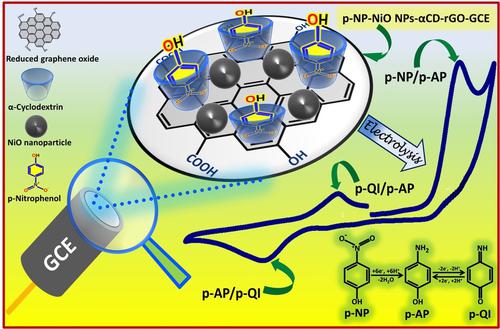当前位置:
X-MOL 学术
›
Electroanalysis
›
论文详情
Our official English website, www.x-mol.net, welcomes your feedback! (Note: you will need to create a separate account there.)
Electrochemical Sensor for Detection of p‐Nitrophenol Based on Nickel Oxide Nanoparticles/α‐Cyclodextrin Functionalized Reduced Graphene Oxide
Electroanalysis ( IF 2.7 ) Pub Date : 2020-11-10 , DOI: 10.1002/elan.202060450 Umme Solaem Akond 1 , Koushik Barman 1, 2 , Abhinandan Mahanta 1 , Sk. Jasimuddin 1
Electroanalysis ( IF 2.7 ) Pub Date : 2020-11-10 , DOI: 10.1002/elan.202060450 Umme Solaem Akond 1 , Koushik Barman 1, 2 , Abhinandan Mahanta 1 , Sk. Jasimuddin 1
Affiliation

|
p‐Nitrophenol (p−NP) is a high priority toxic pollutant and that has harmful effects on human, animals and plants. Thus, the detection and determination of p−NP present in the environment is an urgent as well as highly important requisite. The present article, therefore focused on the construction of a novel electrochemical sensor based on NiO nanoparticles/α‐cyclodextrin functionalized reduced graphene oxide modified glassy carbon electrode (NiO−NPs‐α‐CD‐rGO‐GCE) for the selective and sensitive detection of p−NP. UV‐vis, high resolution transmission electron microscopy (HR‐TEM), selected area electron diffraction pattern (SAED) and X‐ray diffraction (XRD) analysis confirms the formation of highly pure NiO nanoparticles. Field emission scanning electron microscopy (FE‐SEM), energy dispersive X‐ray spectroscopy (EDS), and cyclic voltammetry (CV) were used to characterize the step‐wise electrode modification process. DPV was carried out to quantify p−NP within the concentration range of 1−10 μM and found the detection limit of 0.12 nM on the basis of the signal‐to‐noise ratio S/N=3. The electrode can able to detect different isomers of nitrophenols. Interferences of other pollutants such as phenol, p‐aminophenol, o‐ and m‐ nitrophenol, 4‐chlorophenol, 2,6‐dichlorophenol and ions like K+, Cd2+, Cl−, SO42− did not affect the sensing of p−NP. The newly developed sensor exhibited diffusion controlled kinetics and had excellent sensitivity, selectivity and reproducibility for the detection of p−NP. The electrode showed good recoveries in real sample analysis.
中文翻译:

基于氧化镍纳米粒子/α-环糊精功能化还原氧化石墨烯的对硝基苯酚电化学传感器
对硝基苯酚(p-NP)是高度优先的有毒污染物,对人类,动植物具有有害影响。因此,检测和确定环境中存在的p-NP是紧迫且非常重要的必要条件。因此,本文重点介绍了一种基于NiO纳米颗粒/α-环糊精功能化还原氧化石墨烯修饰的玻碳电极(NiO-NPs-α-CD-rGO-GCE)的新型电化学传感器的构建,用于选择性和灵敏检测p-NP。紫外可见,高分辨率透射电子显微镜(HR‐TEM),选定区域电子衍射图(SAED)和X射线衍射(XRD)分析证实了高纯NiO纳米颗粒的形成。场发射扫描电子显微镜(FE‐SEM),能量色散X射线光谱仪(EDS),和循环伏安法(CV)用来表征逐步电极修饰过程。进行DPV定量分析浓度范围为1-10μM的p-NP,根据信噪比S / N = 3得出检测限为0.12 nM。该电极能够检测硝基酚的不同异构体。其他污染物的干扰,例如苯酚,对氨基苯酚,邻硝基和间硝基苯酚,4-氯苯酚,2,6-二氯苯酚和诸如K的离子+,镉2+,氯-,SO 4 2-不影响对NP的感测。新开发的传感器表现出扩散控制的动力学特性,并具有出色的灵敏度,选择性和重现性,可检测p-NP。电极在实际样品分析中显示出良好的回收率。
更新日期:2020-11-10
中文翻译:

基于氧化镍纳米粒子/α-环糊精功能化还原氧化石墨烯的对硝基苯酚电化学传感器
对硝基苯酚(p-NP)是高度优先的有毒污染物,对人类,动植物具有有害影响。因此,检测和确定环境中存在的p-NP是紧迫且非常重要的必要条件。因此,本文重点介绍了一种基于NiO纳米颗粒/α-环糊精功能化还原氧化石墨烯修饰的玻碳电极(NiO-NPs-α-CD-rGO-GCE)的新型电化学传感器的构建,用于选择性和灵敏检测p-NP。紫外可见,高分辨率透射电子显微镜(HR‐TEM),选定区域电子衍射图(SAED)和X射线衍射(XRD)分析证实了高纯NiO纳米颗粒的形成。场发射扫描电子显微镜(FE‐SEM),能量色散X射线光谱仪(EDS),和循环伏安法(CV)用来表征逐步电极修饰过程。进行DPV定量分析浓度范围为1-10μM的p-NP,根据信噪比S / N = 3得出检测限为0.12 nM。该电极能够检测硝基酚的不同异构体。其他污染物的干扰,例如苯酚,对氨基苯酚,邻硝基和间硝基苯酚,4-氯苯酚,2,6-二氯苯酚和诸如K的离子+,镉2+,氯-,SO 4 2-不影响对NP的感测。新开发的传感器表现出扩散控制的动力学特性,并具有出色的灵敏度,选择性和重现性,可检测p-NP。电极在实际样品分析中显示出良好的回收率。






































 京公网安备 11010802027423号
京公网安备 11010802027423号